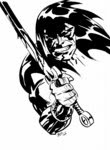Signature Shots: Wes Anderson

Anderson has so many directorial tics its difficult to choose a single one to focus on. Critic Matt Zoller Seitz does a good job of identifying and examining some of the others in these fine video essays , but my favourite of his stylistic trademarks is his fondness for slow motion shots of his characters walking.
Theres one in virtually every film, from a variety of angles and with a slightly different effect in each case.
Firstly, its a visually distinctive shot, and it allows Anderson - an extremely precise and controlled film-maker - absolute control over every facet of a sequence. All of his films feel throughly designed down to the smallest details - the wallpaper, the clothing, the props, and his framing, camera movement and editing are all famously exact. In a slo-mo shot he can also control the flow of time itself through the scene; the tempo of a walk, the length of a tiny pause in dialogue.
In The Darjeeling Limited (2007) there are two memorable slow motion sequences. The opening dash for the departing train, a slapstick affair seen so slowly it can be lingered over and becomes almost beautiful in its casual choreographing of chaos, and the scene of the boy's funeral in the rural Indian village later in the film. This may be a weakness of Anderson's - he does like to slow down the action so that the audience knows for sure that it is witnessing a scene of no little import. This is a funeral, he seems to be saying; it deserves some slow motion.
But then he also uses slo-mo to mark a moment of growth or change for a character. It does indicate a shift in awareness - as in life, temporal reality can seem distorted by any sort of mental alteration. So the funeral in Darjeeling Limited is when the brothers begin to grow up and accept what has happened to them, and Anderson manages to communicate this to us with this visual shorthand while also composing some nice shots of a traditional funeral ceremony.

They key slo-mo moment in The Royal Tenenbaums (2001) is when Richie meets his sister Margot, the love of his life, upon his return to New York City. She steps off a bus and her walk across the pavement is scored by Nico's version of Jackson Browne's "These Days" against some masterful cutting and framing from Anderson. This is a moment loaded with significance for both siblings, and Anderson makes us feel its import, particularly for the miserable Richie. We see Margot's walk - she almost floats, idealised, across the space - as Richie does, since Anderson intercuts it with reaction shots in tight close-up of Richie's face. The use of that song may seem a little predictable and on-the-button for Anderson, but the sequence is a lovely one, and it does justice to the depth of feeling between the characters.

In Rushmore (1998), the beginning of hostilities between Max and Herman is marked with some slow motion. Max, having released some bees into Herman's hotel room, swaggers confidently from an elevator as the live version of "A Quick One" by the Who rattles away on the soundtrack. It is a macho, cocky passage of rock music - as is much of the other British Invasion stuff Anderson favours in that film - and there is an obvious comedy in the disparity between Max and the music soundtracking his adventures. In general, though, Anderson seems to prefer to use slow motion in more emotional, meaningful scenes, such as the oddly poignant conclusion to Bottle Rocket (1996), his feature-length debut, where Dignan is led away in the Prison yard and looks back over his shoulder as he walks.

Or indeed the quietly euphoric ending of The Life Aquatic (2005) in which Zissou and his extended family and crew walk down a Red Carpet to the premiere of his new film, Zissou carrying Klaus' nephew on his shoulders, and the rhythm of a walk down steps gives the shot a lovely sense of its own internal timing, a sort of steady rolling wellbeing. Its a lovely shot, something Anderson is always capable of, and the fact that he has resisted slow motion in the heaviest and most emotional scene at an earlier point in the film - the funeral of Ned, Zissou's son - gives the use of the technique here a heightened impact.
Labels: slow motion, wes anderson



0 Comments:
Post a Comment
<< Home